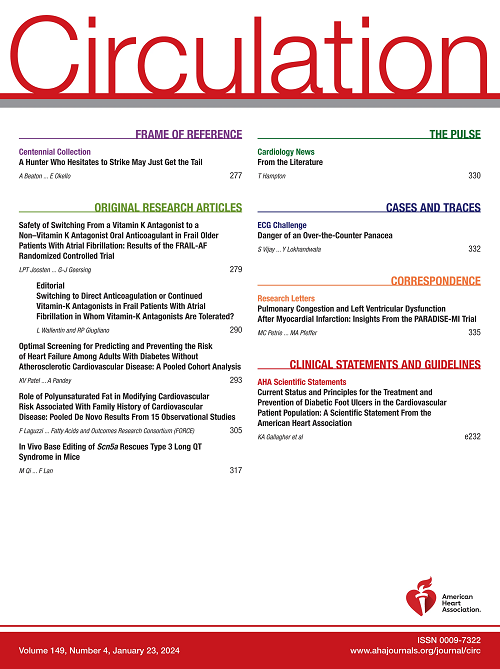TAX1BP3是一种苏甲基化的核细胞质穿梭蛋白,可防止血管内膜增生。
IF 38.6
1区 医学
Q1 CARDIAC & CARDIOVASCULAR SYSTEMS
引用次数: 0
摘要
背景:新生内膜增生是动脉介入治疗后血管并发症的主要原因。尽管药物洗脱支架等策略在减少新生内膜增生方面取得了进展,但实现持续有效的长期结果仍然是一个挑战。由PDZ (PSD-95、disc -large和ZO-1)结构域介导的蛋白-蛋白相互作用对许多生物过程至关重要。然而,人们对PDZ蛋白在新内膜形成中的作用知之甚少。本研究旨在探讨单一PDZ蛋白TAX1BP3 (Tax1 binding protein 3)在血管平滑肌细胞(VSMCs)表型转换中的作用及其在新生内膜增生中的意义。方法观察TAX1BP3在新生内膜形成小鼠离体VSMCs或动脉中的亚细胞定位。构建TAX1BP3突变体,研究sumo化对TAX1BP3核质穿梭的影响。生成vsmc特异性Tax1bp3敲除小鼠,以确定颈动脉丝损伤模型的相关表型。为了阐明潜在的分子机制,研究人员进行了RNA测序、转座酶可及染色质测序、复杂结构的计算预测和共免疫沉淀。采用aav介导的Tax1bp3基因传递和工程AIENP-TAX1BP3来研究潜在的翻译相关性。结果stax1bp3在VSMCs表型转换过程中表现出动态的核胞质穿梭。TAX1BP3在K116位点被summoylation,其summoylation对于维持TAX1BP3的核定位至关重要。缺乏TAX1BP3促进了小鼠血管损伤后从收缩型向合成型的转变,并加剧了新生内膜的形成。RNA测序和转座酶可及染色质测序的结合表明,TAX1BP3主要通过YAP-TEAD转录活性调节VSMCs的细胞周期进程和细胞增殖。TAX1BP3/YAP1复合物结构的计算预测和蛋白相互作用相关实验表明,TAX1BP3和TEAD1通过其TEAD结合域(BD)以非规范的PDZ方式竞争与YAP的结合。aav介导的Tax1bp3基因传递可显著减轻损伤后新内膜的形成和动脉粥样硬化的进展。给药AIENP-TAX1BP3可有效减少VSMC表型转换和新生内膜增生。结论在VSMCs表型转换过程中,TAX1BP3在K116位点的sumo化使其核胞质穿梭。TAX1BP3以非典型PDZ方式与YAP-TEAD复合物竞争性相互作用,主要通过调节细胞增殖在血管内膜增生中发挥保护作用。本文章由计算机程序翻译,如有差异,请以英文原文为准。
TAX1BP3 Is a SUMOylated Nucleocytoplasmic Shuttling Protein and Protects Against Vascular Neointimal Hyperplasia.
BACKGROUND
Neointimal hyperplasia is the major cause of significant vascular complications after arterial interventions. Despite the advancements in strategies such as drug-eluting stents to minimize neointimal hyperplasia, achieving consistently effective long-term outcomes remains a challenge. Protein-protein interactions mediated by PDZ (PSD-95, Discs-large, and ZO-1) domains are essential for numerous biological processes. However, little is known about the role of PDZ proteins in neointima formation. This study aims to explore the role of TAX1BP3 (Tax1 binding protein 3), a singular PDZ protein, in phenotypic switching of vascular smooth muscle cells (VSMCs) and its implication in neointimal hyperplasia.
METHODS
Subcellular localization of TAX1BP3 was assessed in isolated VSMCs or arteries obtained from mice with neointima formation. TAX1BP3 mutants were constructed to study the role of SUMOylation on TAX1BP3 nucleocytoplasmic shuttling. VSMC-specific Tax1bp3 knockout mice were generated to determine the relevant phenotypes in a carotid artery wire injury model. RNA sequencing, assays for transposase-accessible chromatin using sequencing, computational prediction of complex structures, and coimmunoprecipitation were performed to elucidate the underlying molecular mechanisms. AAV-mediated Tax1bp3 gene delivery and engineered AIENP-TAX1BP3 were employed to investigate the potential translational relevance.
RESULTS
TAX1BP3 exhibited dynamic nucleocytoplasmic shuttling during phenotypic switching of VSMCs. TAX1BP3 is SUMOylated at K116, and its SUMOylation is essential for maintaining the nuclear localization of TAX1BP3. Deficiency of TAX1BP3 facilitated the transition from a contractile to a synthetic phenotype and aggravated neointima formation after vascular injury in mice. The integration of RNA sequencing and an assay for transposase-accessible chromatin using sequencing unveiled that TAX1BP3 primarily regulated the cell cycle progression and cell proliferation of VSMCs through YAP-TEAD transcription activity. The computational prediction of TAX1BP3/YAP1 complex structures and protein interaction-related experiments revealed that TAX1BP3 and TEAD1 compete for binding to YAP through its TEAD binding domain (BD) in a noncanonical PDZ manner. AAV-mediated Tax1bp3 gene delivery significantly attenuated postinjury neointima formation and the progression of atherosclerosis. AIENP-TAX1BP3 administration effectively reduced VSMC phenotypic switching and neointimal hyperplasia.
CONCLUSIONS
These results demonstrate that SUMOylation of TAX1BP3 at K116 enables its nucleocytoplasmic shuttling during phenotypic switching of VSMCs. TAX1BP3 competitively interacts with the YAP-TEAD complex in a noncanonical PDZ manner and exerts its protective role in vascular neointimal hyperplasia primarily through the regulation of cell proliferation.
求助全文
通过发布文献求助,成功后即可免费获取论文全文。
去求助
来源期刊

Circulation
医学-外周血管病
CiteScore
45.70
自引率
2.10%
发文量
1473
审稿时长
2 months
期刊介绍:
Circulation is a platform that publishes a diverse range of content related to cardiovascular health and disease. This includes original research manuscripts, review articles, and other contributions spanning observational studies, clinical trials, epidemiology, health services, outcomes studies, and advancements in basic and translational research. The journal serves as a vital resource for professionals and researchers in the field of cardiovascular health, providing a comprehensive platform for disseminating knowledge and fostering advancements in the understanding and management of cardiovascular issues.
 求助内容:
求助内容: 应助结果提醒方式:
应助结果提醒方式:


